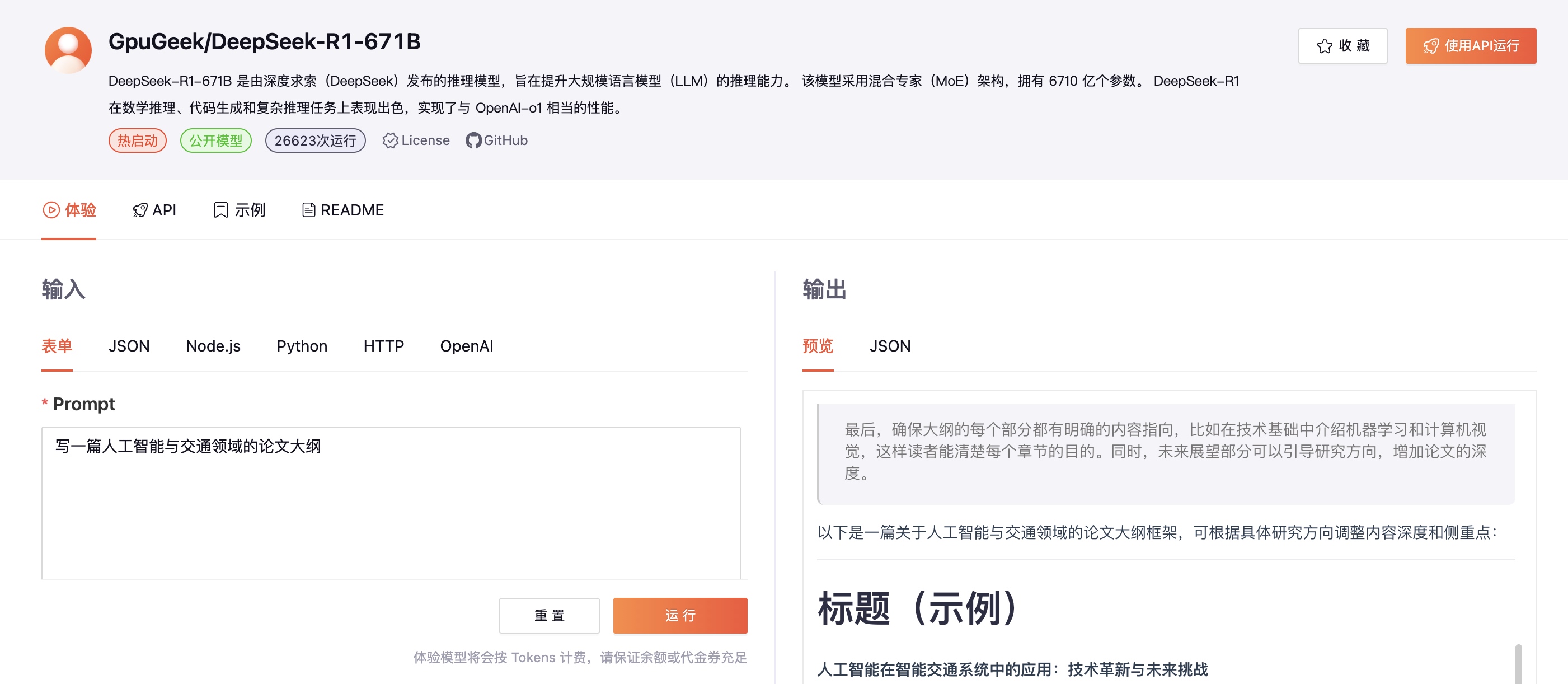Model Invocation
You can invoke models through the interface experience area and API.
Model Experience
Each model has its own experience interface. You can fill in model request parameters through a web form, and the output results will be displayed on the interface. The first run of a model can be tested this way, and later you can use the API method for stable usage. Both model experience and API invocation will be charged based on each call volume (such as the number of tokens) or the runtime of the request.

API Invocation
You can request each model's API in multiple ways, including HTTP, Node.js, and Python. For text dialogue official APIs, OpenAI format compatibility is supported. API invocation requires an API Key, which can be viewed and managed on the API Key page.
Invoke API via HTTP
curl -X POST "https://api.gpugeek.com/predictions" \
-H "Authorization: Bearer your_api_key" \
-H "Content-Type: application/json" \
-H "Stream: true" \
-d "{\"model\": \"GpuGeek/DeepSeek-R1-671B\", \"input\": {
\"frequency_penalty\": 0,
\"max_tokens\": 8192,
\"prompt\": \"\",
\"temperature\": 0.6,
\"top_p\": 0.7
}}"
Invoke API via Python Client
Import the requests module
API_KEY = "your_api_key"
Set the request url
url = 'https://api.gpugeek.com/predictions';
Set request headers
headers = {
"Authorization": f"Bearer {API_KEY}",
"Content-Type": "application/json",
"Stream": "true"
}
Set request parameters
data = {
"model": "GpuGeek/DeepSeek-R1-671B", # Replace with your model name
# Replace with actual input parameters
"input": {
"frequency_penalty": 0,
"max_tokens": 8192,
"prompt": "",
"temperature": 0.6,
"top_p": 0.7
}
}
Send the POST request
response = requests.post(url, headers=headers, json=data)
Check response status code and print response content
if response.status_code == 200:
for line in response.iter_lines():
if line:
print(line.decode("utf-8"))
else:
print("Error:", response.status_code, response.text)
Invoke API via Node.js Client
Import the axios module and the stream module
const axios = require('axios');
const { Readable } = require('stream');
Set the API_KEY variable
const API_KEY = 'your_gpugeek_api_token';
Set the request URL
const url = 'https://api.gpugeek.com/predictions';
Set request headers
const headers = {
"Authorization": "Bearer API_KEY",
"Content-Type": "application/json",
"Stream": "true"
};
Request body data
const data = {
"model": "GpuGeek/DeepSeek-R1-671B", // Replace with your model name
// Replace with actual input parameters
input: {
"frequency_penalty": 0,
"max_tokens": 8192,
"prompt": "",
"temperature": 0.6,
"top_p": 0.7
},
};
Send the POST request
axios.post(url, data, {
headers: headers,
responseType: 'stream' // Set response type to stream
})
.then(response => {
const readableStream = Readable.from(response.data);
readableStream.on('data', (chunk) => {
console.log(chunk.toString('utf-8'));
});
readableStream.on('error', (err) => {
console.error('Stream error:', err.message);
});
})
.catch(error => {
if (error.response) {
console.error("Error:", error.response.status, error.response.statusText);
} else {
console.error("Error:", error.message);
}
});
OpenAI-Compatible Mode
Install OpenAI
pip install openai==1.63.2
Import the OpenAI module
from openai import OpenAI
Initialize the OpenAI client
client = OpenAI(
api_key="your_api_key", # your api key
base_url="https://api.gpugeek.com/v1", # endpoint
)
Send request
stream = client.chat.completions.create(
model="GpuGeek/DeepSeek-R1-671B",
stream=True,
frequency_penalty=0,
max_tokens=8192,
messages=[
{
"role": "user",
"content": "",
}
],
temperature=0.6,
top_p=0.7,
)
for chunk in stream:
print(chunk.choices[0].delta.content)